
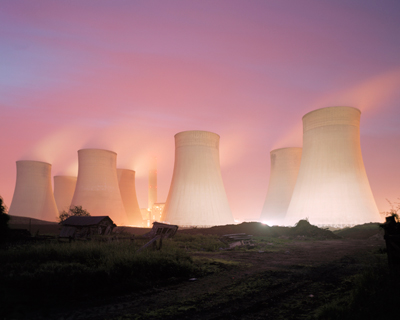
Photography by Toby Smith. Courtesy of Toby Smith/Reportage by Getty Images

Having focused his lens on illegal logging practices in Madagascar and on the thirty-two coal-fired power stations in his native England for past investigative photo essays, reportage photographer
Toby Smith now turns to the promising renewable energy sources of the future. For his first exhibition in the planned series that he is calling
The Renewables Project, he has captured snapshots of a power generation scheme that is actually far from new and has in fact been supplying electricity for decades essentially free of carbon emissions.
Over the course of three months last winter in the Scottish Highlands, Smith exhaustively studied the region’s hydroelectric dams through his camera. With simple composition and framing, and by using long exposures, he has produced images that affectingly convey the vastness of the engineering systems at work and of the surrounding environment. The project is consistent with his regular approach of examining the nexus between ecology and human activity in a manner that brings to mind the Canadian photographer Edward Burtynsky’s reliably astonishing industrial landscapes. Before heading to China, where he will continue to explore alternative energy sources, Smith spoke to PLANET about the photos that he hopes will inspire an honest debate.
(more…)

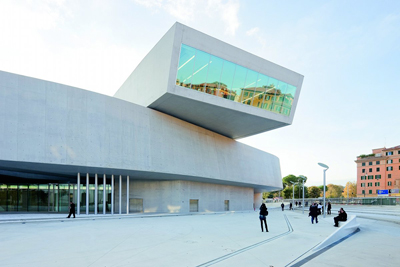
Exterior view of Suite V from the plaza. All photography by Iwan Baan.
(Click images to enlarge)


No other contemporary architect has a formal language as seductive and expressive as Zaha Hadid’s. Her work has sidestepped the conventional forms of modern architecture (rigid boxes and planes) for something altogether different (warped and tilted vectors) with complete assurance.
Hadid’s new museum for contemporary art in Rome, MAXXI: Zaha Hadid Architects. In addition to a portfolio of masterful photographs by Iwan Baan, the volume contains insightful essays about the building’s design and development, architectural plans, detail drawings, and construction photos. It’s eye-opening to understand the immense coordination efforts, and also the vast grid of steel reinforcing, that were required to get this building up.
Since the project spanned from 1999, when Hadid’s office first won a design competition, to 2009, when construction was completed, MAXXI is a powerful summation of the ideas the architect explored during these fruitful years. Chief among them is the notion that buildings aren’t static constructions but complex, mutable entities that emerge from fields of energy and activity at a site. That idea is given full, clear expression at MAXXI. The building’s long curved walls follow the outline of the L-shaped site and retract and expand in response to adjacent street grids. The compressed, overlapping forms recreate the density of traditional Roman city blocks, and echo adjacent military barracks, train tracks, and the curve of the Tiber River. The structure looks strikingly contemporary and still sits comfortably within this very old city.
(more…)

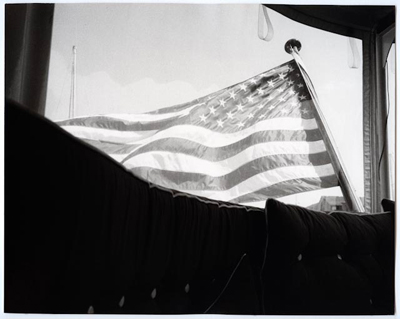
Photography by Andy Warhol. Courtesy of The Andy Warhol Foundation for the Visual Arts, Inc. (Click images to enlarge)


It feels like everything has been said about Andy Warhol. Each year seems to produce another biography, another collaboration, another exhibition. Not that Warhol is turning in his grave — he would have loved the undying attention. But to say something fresh about him has become a challenge, one that Deborah Bell was more than happy to undertake with her new exhibition,
Andy Warhol’s Street Diary.
“This show is all about Andy’s eye for composition, light, for formal arrangements, for detail,” Bell said at the opening reception. “I always knew that Andy was interested in photography, but it was usually as a means to an end. These were the end product.”
All the prints in the exhibition are unique, although their variants have been used for Warhol’s stitched photographs. The twenty-five black and white pictures depict him as a flaneur who loved wandering the streets of New York documenting its minutia. The photos carefully juxtapose the grand against the mundane, and this coexistence of diamonds and trash is what gives New York its character. Here is an Yves-Saint Laurent shop window, and here is the flea market, the garbage can and the Rockefeller center Christmas tree. In the catalogue that accompanies the exhibit Jonas Mekas rightly notes that Warhol did not pass judgment on his subjects, and the photos in the exhibition speak to that.
Andy Warhol’s Street Diary, Photographs 1981-1986 at
Deborah Bell Photographs, 511 West 25th St., Suite 703, New York.
(more…)
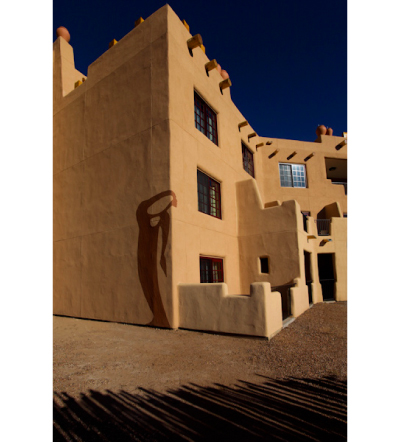
Watchers, Rose B. Simpson. TIME was photographed by award winning, Santa Fe based photographer, Julien McRoberts who is renown for her stunning imagery of the Southwest.

Every now and then, a project comes around that belts you in the brain, creating one of those “aha!” moments we all love but can’t anticipate. TIME stands for Temporary Installations Made for the Environment and has been around since 2005. This year’s exhibition is the first under the direction of fine art consultant and gallery owner Eileen Braziel, and was photographed by award-winning Santa Fe-based photographer Julien McRoberts, renowned for her stunning imagery of the Southwest. The state-driven art project (funded by the New Mexico One Percent for the Arts act as part of the Art in Public Places program) has chosen “Green Technologies/Innovative Ideas or Materials” for its 2010 theme and features everything from a hand-painted tipi and adobe windmills to biodegradable glass bowls and solar-powered lights.
According to Braziel, New Mexico is an ideal setting for the ongoing project. “In New Mexico we understand that the first innovators were the Native Indians and settlers. Solar, wind, and water are the most fundamental elements guiding green technology, and often drive ideas in New Media art installations where artists are using solar panels, LED lights, LED projectors, etc.” Additional materials used in the exhibit include traditional adobe bricks, earth, seed, biodegradable soap and recycled metals from the Los Alamos Laboratory. A barcode located on the plaque of each installation allows viewers to download free information about each artist using their phones, completely eliminating the use of paper.
(more…)
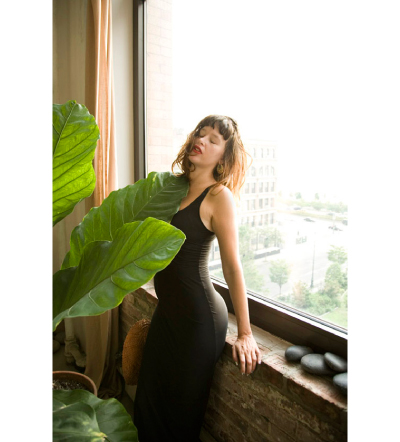
Photography by Derek Peck. Click Image for Slideshow

From my regular column in AnOther magazine.
The first time I heard the name Paz de la Huerta I assumed she must be very famous and that I had simply missed her on my radar. Her name has that ring, that majesty; it’s the kind of name you want to repeat to yourself out loud, just for the pleasure of hearing it. De. La. Huer. Ta. Did Nabokov name her? Like all European names, the “de” suggests a lineage descending from aristocracy. Maybe it’s that same background that has made it possible for Paz to be so nonchalantly late today. Who knows? In any case, somewhere out there, among the jostling, overambitious hoards of Manhattan, making her way from Midtown to Tribeca, where I wait for her, walks a beautiful young actress, a woman whose name means “Peace” in Spanish, and who is about to be famous beyond her wildest dreams (or perhaps exactly like them).
When Paz finally arrives, exiting onto the floor from a vintage 1930s-era elevator carriage, she is damp with August heat, the sweltering greenhouse reality that has been our New York summer. It’s not the most flattering way to meet a starlet, but Paz pulls it off with an aplomb that is serene and unapologetic. After a brief greeting she excuses herself to the washroom, douses her face and hair with cold water, then curls up in an armchair, sufficiently cooled.
(more…)

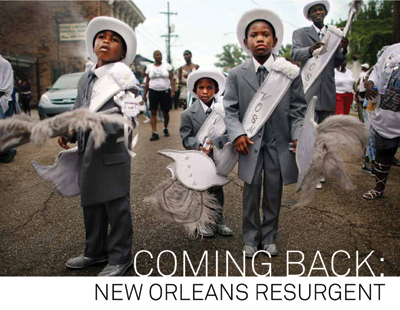
Photography by Mario Tama, courtesy of Umbrage Editions.


In the immediate aftermath of Hurricane Katrina, New Orleans became a magnet for photographers, journalists, and 24-hour media attention. But not too many of them stuck around for the slow, problem-addled rebuilding process, and of those who did, few have captured the city and its embattled residents as poignantly as Getty Images photographer Mario Tama. In his tireless efforts to document the unprecedented levels of destruction, Tama has amassed a collection of images unique in the way in which they showcase the small moments of hope and resilience that accompany tragedy and frustration.
On the heels of the hurricane’s fifth anniversary, Tama has collected his award-winning snapshots in
Coming Back: New Orleans Resurgent, featuring photos that highlight both the ongoing need for recovery and the unbelievable tenacity of the city’s residents. The book, which also has an introduction courtesy of Anderson Cooper, was released this past weekend and is a sharp reminder of the power of photojournalism done well.
In the meantime, Tama’s work is also being showcased in twin exhibits in New Orleans and in New York at Brooklyn’s
Umbrage Gallery — be sure to catch it before it closes this Wednesday. A portion of proceeds will go toward New Schools for New Orleans, a non-profit that has been instrumental in updating the city’s public education system.
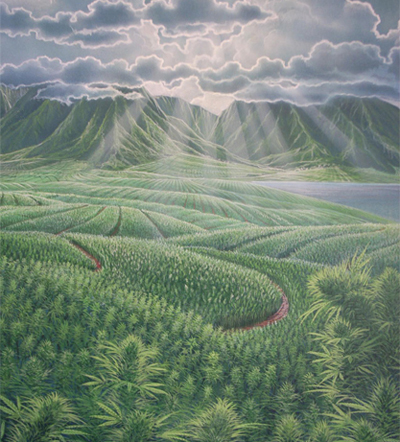
Hemp Fields, Richard Fields. 1995. Photography courtesy of Puka Puka. (Click images to enlarge)

“The Hawaiian spirit…was the ambient culture that we walked into and sucked up,” says artist and activist Joana Varawa of Hawaii in the 1960s. The bohemians, hippies, artists, beatniks, explorers of consciousness — there are too many words for them, and none come quite close enough to the truth — came to the island for various reasons: art, nature, the surf, to escape an outstanding warrant for one’s arrest. And the pilgrims found what was at that time a veritable paradise, relatively unspoiled by the touch of Western civilization. Ratified as a state in the latter half of 1959, Hawaii in the 1960s reflected the counterculture’s utopian ideals: a place to explore one’s inner and outer worlds amidst the otherworldly sensation of “hot lava under foot, volcanoes over head”.
FAR ART, the unprecedented exhibition at Puka Puka boutique and gallery in Maui, opened this summer on the 40th anniversary of “Rainbow Bridge”, Jimi Hendrix’s penultimate concert. The exhibition includes works by still-renegade artists such as William Ballantine III (aka TABULATOR), who smoked a joint with Hendrix himself and is currently conducting experiments in “cosmic consciousness”. Also John Schofill (creator of the original, iconic sign for Rainbow Bridge), early animal welfare activist Joana Varawa, and John Severson, the founder of Surfer Magazine.
After the jump, find our interview with Nathan and Alizé, the gallery founders and exhibition curators, about the “super-cosmic” way in which the show came together, the appeal of Hawaii, and what, exactly, the term “rainbow bridge” means.
(more…)
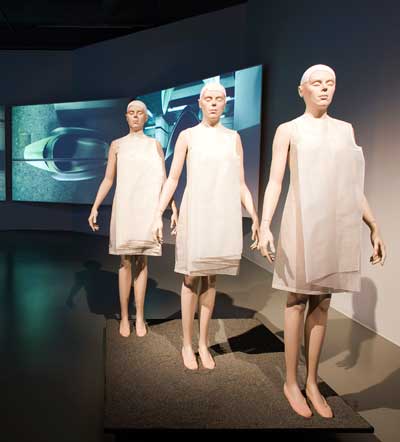
Photography courtesy of Istanbul Museum of Modern Art (Click images to enlarge)

Nomadism. Technology. Migration. Utopia. Body Politics. The myriad themes considered in the work of Hussein Chalayan are unlike that of any other contemporary fashion designer. Hussein Chalayan uses fashion as a medium for presenting and discussing the semiotics of clothing. Chalayan interrogates standard cultural signs and materials by demystifying the common values related to fashion such as superficiality and frivolousness.
After graduating from the Türk Maarif College, Chalayan continued his studies at London’s Saint Martin’s School of Art. For his senior thesis project in 1993, his Tangent Flows collection featured silk dresses that had been covered in iron filings, buried in the ground for months and then unearthed just before the show and presented with a text that explained the process. The garment’s rituals of burial and resurrection referred to life, death, and urban decay in material objects. This collection not only launched his career (his label was created only a year later in 1994), but helped him achieve global success as someone working between the complex mix of contemporary artist and fashion designer. Chalayan has twice been named British Designer of the Year and has received numerous awards and honors since Tangent Flows.
(more…)
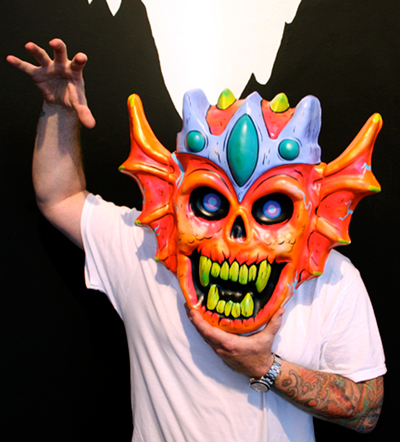
Justin Giarla with one of Skinner's masks

If San Francisco is the renegade city of the art world, Justin Giarla is most definitely captain of the ship. Since first opening the Shooting Gallery in 2003 (in a neighborhood that gently put, is a little shady), he’s become the shining beacon of a city excluded from both the nexus of New York City and the star-studded vault of Los Angeles, a city no longer taken seriously when it comes to fine art. Specializing in urban contemporary and pop surrealism, Giarla’s spreads his expertise between four different art spaces including Gallery Three and the Shooting Gallery’s influential sister gallery, White Walls. Known in local circles as equal parts philanthropist and curator, Giarla’s work outside the galleries speaks at even higher volumes about his commitment to community engagement through the conduit of art. He hosts annual fundraisers for local nonprofits and is closely involved with Hospitality House, an organization that offers facilities and art resources to the homeless free of charge, no questions asked.
Giarla’s newest progeny, 941 Geary will host its inaugural show on September 18 with a circus-inspired “art opera of epic proportions” including real life carnies and interactive games courtesy of Mike Shine. PLANET picks the brain of the man who is single-handedly attempting to reinvigorate the San Francisco art culture by example and sheer force of will.
(more…)





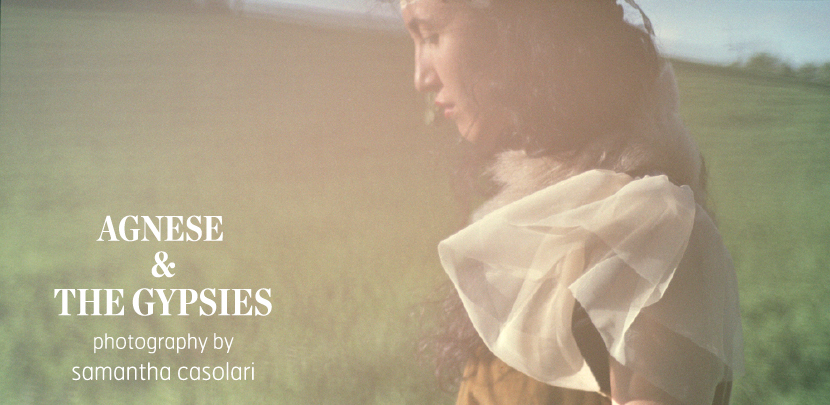
 Facebook
Facebook Permalink
Permalink Digg
Digg Reddit
Reddit LinkedIn
LinkedIn StumbleUpon
StumbleUpon Tumblr
Tumblr














